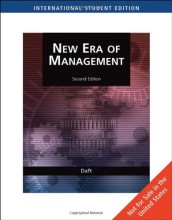Summary: New Era Of Management | 9780324537772 | Richard L Daft
- This + 400k other summaries
- A unique study and practice tool
- Never study anything twice again
- Get the grades you hope for
- 100% sure, 100% understanding
Read the summary and the most important questions on New era of management | 9780324537772 | Richard L. Daft.
-
1 Operations and value chain management
-
1.1 MOCK
This is a preview. There are 9 more flashcards available for chapter 1.1
Show more cards here -
When does an ethical dilemma arise?
An ethical dilemma arises in a situation when each alternative choice or behavior is undesirable because of potentially harmful ethical consequences.
-
Is effective implementation still a necessity if the strategies are truly creative?
Yeah, d'oh. !
-
What is a performance gap?
The difference between the current situation and the intended situation.
Performance gap analysis helps a business identify how far it has come toward reaching its goals and how far it still needs to go to attain them, with the objective of developing a concrete strategy to close any existing gap.
-
What are the three distinct steps that organizational development specialists identify for achieving behavioral and attitudinal changes?
Unfreezing, intervention and refreezing.
Unfreezing is getting the people affected by change to believe that change is needed.
During the change Intervention itself, workers and managers are changing their behavior and work practices.
Refreezing is supporting and reinforcing the new changes so that they "stick". -
Explain the term lean manufacturing and describe how it is related to productivity.
Lean manufacturing = process using highly trained employees at every stage of the production process to cut waste and improve quality. Eliminate costs that do not contribute to customer value.
-Employee involvement is key-Employees are empowered to make changes (authority and responsibility)
Productivity = organization’s output of products and services divided by its inputs.
So if the inputs decrease without decrease in output, ur productivity rises. -
What are the characteristics of a high-performance culture and explain why it is of importance to survive?
A high-performance culture is a culture that is based on a solid organizational mission or purpose. It embodies shared adaptive values that guide decisions and business practices, and encourages individual employee ownership of both bottom-line results and the organization’s cultural backbone.
It is important to survive, because this culture adapts to changes in the environment which continuously occur to meet strategic goals as the culture has an significant impact on performance. -
Describe strategy, style and skills of your project company and explain how these are interrelated.
Our company has a product leader strategy, a more coaching and supporting style ( small business informal ) and they have the skills for eco-friendly fishing of the mittencrab.
Having a product leader strategy to have those differentiated products the skills are needed to catch the mittencrabs in a ecofriendly way, with that comes the coaching and supporting syle of management which fits in their culture, because is is small kinda family business. -
When analyzing a company, McKinsey 7S model is often used. What is the purpose and when will you use it?
The purpose of the 7s model is to see how the internal elements of the company are aligned. How better they are aligned how better the value creation
-It can be used as a tool for internal strengths for a SWOT analyses
-To see where changes can be made to improve the performance
-Examine how future changes might have an effect on the 7ses of the company
-Align departments or processes during a merger or acquisition
-Determine how to best implement a strategy-It can also be used in teamwork/poject groups
-
Non-routine messages can be effectively communicated by selecting rich channel and routine messages can be efficiently communicated through channel lower in richness. Explain and give an example of both.
Rich channel is personal, 2-way and fast. Low rich channel is impersonal, one way and slow.
Here there is also a trade of between efficiency and effectivity.
Example of rich channel is talking face-2-face and an example of low rich channel is a bulletin bord. -
What are the differences between a dialogue and a discussion? How would the result (outcome) of each probably look like ?
Dialogue:
A dialogue is more emotional versus a discussion that is more based on rationality.
A dialogue is more of a win-win mentality and a discussion a win-lose.
In a dialogue interests of both parties are being explored and they look at options for mutual gain, they get to be creative, which might lead to long term solutions.
In a discussion own interests are most important, they don't think outside of the box, this way short-term solutions are found.
- Higher grades + faster learning
- Never study anything twice
- 100% sure, 100% understanding
































